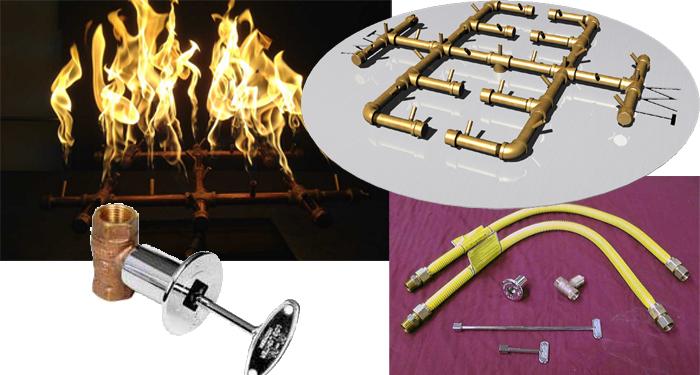Comparing Wood Burning and Gas Burning Fire Pits: The Pros and Cons
Posted by The Fire Pit Store on 27th Jan 2024
Fire pits have become a popular addition to outdoor spaces, providing a cozy and inviting atmosphere for gatherings with friends and family. When it comes to choosing the right type of fire pit, the decision often boils down to wood burning or gas burning options. Each has its own set of advantages and disadvantages, catering to different preferences and needs. In this article, we will delve into the pros and cons of both wood burning and gas burning fire pits to help you make an informed decision for your outdoor space.
Wood Burning Fire Pits

Pros:
- Authentic and Aesthetic Appeal:
- One of the most significant advantages of wood burning fire pits is the authentic and rustic ambiance they create. The crackling sound of burning wood and the mesmerizing dance of flames add a natural and timeless charm to outdoor spaces.
- Cost-Effective:
- Wood is generally more affordable than natural gas or propane. For those looking for a budget-friendly option, wood burning fire pits offer an economical choice for creating a warm and inviting atmosphere.
- Versatility of Fuel:
- Wood burning fire pits allow for the use of various types of wood, providing users with the flexibility to experiment with different aromas and colors of flames. This versatility allows individuals to customize their fire pit experience.
- High Heat Output:
- Wood burning fire pits tend to generate more heat compared to gas burning counterparts. This can be particularly advantageous in colder climates, providing a more effective source of warmth during chilly evenings.
- Culinary Uses:
- Wood burning fire pits can double as outdoor cooking appliances. With the addition of a grill or cooking grate, you can enjoy the experience of cooking over an open flame, adding a unique flavor to your meals.
Cons:
- Mess and Maintenance:
- The process of preparing, lighting, and maintaining a wood burning fire pit can be messy. Dealing with ashes, chopping wood, and cleaning the fire pit after use can be time-consuming and may require more effort compared to gas burning alternatives.
- Smoke and Emissions:
- Wood burning fire pits produce smoke and emissions, which can be a concern for those with respiratory issues or allergies. Additionally, the environmental impact of burning wood should be considered, as it contributes to air pollution.
- Inconsistent Flames:
- Achieving a consistent flame in a wood burning fire pit can be challenging. Factors such as the type of wood, moisture content, and airflow can influence the flame's size and intensity, leading to an unpredictable experience.
- Limited Control:
- Controlling the flame intensity and heat output in a wood burning fire pit is more challenging compared to gas burning options. Once the wood is ignited, it can be difficult to adjust the fire to meet specific preferences.
Gas Burning Fire Pits
Pros:
- Convenience and Ease of Use:
- Gas burning fire pits are incredibly convenient, offering easy ignition with a flip of a switch or the push of a button. This eliminates the need for gathering and storing wood, making it a hassle-free option for those seeking simplicity.
- Clean and Smoke-Free:
- Gas burning fire pits produce minimal smoke and emissions, creating a cleaner and more environmentally friendly option. This is especially beneficial for individuals with respiratory sensitivities or in areas with strict air quality regulations.
- Adjustable Flame and Heat Control:
- Gas fire pits provide precise control over flame height and heat output. With adjustable knobs, users can easily customize the intensity of the flames, creating a comfortable and controlled environment for various occasions.
- Low Maintenance:
- Gas burning fire pits require less maintenance than their wood burning counterparts. There is no need to clean ashes or deal with the residue left by burning wood. Regular checks for gas leaks and occasional cleaning are usually sufficient.
- Versatility in Design:
- Gas fire pits come in various designs and materials, offering a wide range of options to complement different outdoor aesthetics. They can be integrated into tables, built into structures, or installed as standalone units, providing flexibility in design choices.
Cons:
- Higher Initial Cost:
- The upfront cost of installing a gas burning fire pit is typically higher than that of a wood burning fire pit. This includes the cost of the fire pit itself, installation, and any necessary gas lines or propane tanks.
- Dependence on Gas Supply:
- Gas fire pits rely on a constant supply of natural gas or propane. In the event of a power outage or if the gas supply is interrupted, the fire pit may become inoperable, limiting its use during such circumstances.
- Limited Aesthetic Appeal:
- Some individuals argue that gas burning fire pits lack the authenticity and charm of a wood burning fire pit. The flames in gas fire pits may not have the same natural flickering effect as those produced by burning wood, which can impact the overall ambiance.
- Less Intense Heat Output:
- While gas burning fire pits provide adequate warmth, they may produce less intense heat compared to wood burning options. This may be a consideration for those living in colder climates seeking a more robust heat source.
- Less Culinary Versatility:
- Unlike wood burning fire pits, gas fire pits are not well-suited for cooking. While there are options with built-in grills or cooking surfaces, they may not offer the same flavor infusion as cooking over an open wood flame.
Choosing between a wood burning and gas burning fire pit ultimately depends on individual preferences, lifestyle, and priorities. Each option has its own set of advantages and disadvantages, catering to different needs and tastes.
If you prioritize authenticity, a traditional and natural ambiance, and enjoy the process of tending to a fire, a wood burning fire pit may be the ideal choice for you. However, be prepared for the additional effort and mess associated with wood burning.
On the other hand, if convenience, cleanliness, and precise control over the fire's intensity are more important to you, a gas burning fire pit might be the better option. While it may require a higher initial investment, the ease of use and low maintenance could outweigh the upfront cost for some individuals.
Ultimately, whether you opt for the crackling warmth of a wood burning fire pit or the modern convenience of a gas burning alternative, both options offer the opportunity to create memorable moments and a cozy atmosphere in your outdoor space. Consider your lifestyle, preferences, and the specific requirements of your outdoor area to make the right choice for your needs.


